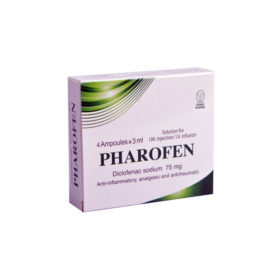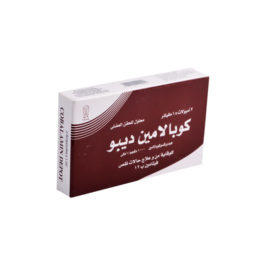Description
therapeutic Indications:
Ketoprofen is an analgesic, anti-inflammatory and antipyretic and is recommended for the treatment of:
-Rheumatoid arthritis, osteoarthritis and ankylosing spondylitis
-Other musculoskeletal conditions including bursitis, capsulitis, synovitis, tendinitis, fibrositis and low back pain
-The relief of pain from sciatica, acute gout and dysmenorrhoea.
Posology and method of administration:
Route of Administration
For oral administration
Dosage Recommendations
Undesirable effects may be minimised by using the lowest effective dose for the shortest duration necessary to control symptoms.
The maximum daily dose is 200mg. The balance of risks and benefits should be carefully considered before commencing treatment with 200mg daily, and higher doses are not recommended.
Adults
One 200 mg capsule to be taken orally once daily, preferably with or after food.
The Elderly
As for adult dosage as there is no evidence that the pharmacokinetics of ketoprofen are altered in the elderly.
The elderly are at risk of increased risk of the serious consequences of adverse reactions. If an NSAID is considered necessary, the lowest effective dose should be used and for the shortest possible duration. The patient should be monitored regularly for gastrointestinal bleeding during NSAID therapy.
Children
There are no recommendations for the use of this product in children.
Contraindications:
Hypersensitivity to ketoprofen or to any of the excipients.
Active peptic ulcer or any history of gastrointestinal bleeding, ulceration or perforation
NSAIDs are contraindicated in patients who have previously shown hypersensitivity reactions (e.g., asthma, rhinitis, angioedema, urticaria), in response to ibuprofen, aspirin or other non-steroidal anti-inflammatory drugs
Severe heart failure, hepatic failure and renal failure.
During pregnancy.
History of gastrointestinal bleeding or perforation, related to previous NSAIDs therapy.
WARNINGS AND PRECAUTIONS:
Cardiovascular Risk
NSAIDs may cause an increased risk of serious cardiovascular thrombotic events, myocardial infarction, and stroke, which can be fatal. This risk may increase with duration of use. Patients with cardiovascular disease or risk factors for cardiovascular disease may be at greater risk. NSAIDs are contraindicated for the treatment of peri-operative pain in the setting of coronary artery bypass graft (CABG) surgery.
Gastrointestinal Risk
NSAIDs cause an increased risk of serious gastrointestinal adverse events including inflammation, bleeding, ulceration, and perforation of the stomach or intestines, which can be fatal. These events can occur at any time during use and without warning symptoms. Elderly patients are at greater risk for serious gastrointestinal events.
Undesirable effects may be minimised by using the lowest effective dose for the shortest duration necessary to control symptoms.
The use of KETOGESIC 200 SR capsules with concomitant NSAIDs including cyclooxygenase-2 selective inhibitors should be avoided.
As with other drugs in the same therapeutic category, patients should be advised to take ketoprofen with food, to minimise gastric intolerance.
Elderly
The elderly have an increased frequency of adverse reactions to NSAIDs especially gastrointestinal bleeding and perforation which can be fatal.
Respiratory disorders
Caution is required if administered to patients suffering from, or with a previous history of, bronchial asthma since NSAIDs have been reported to precipitate bronchospasm in such patients.
Cardiovascular, renal and Hepatic Impairment
The administration of an NSAID may cause a dose dependent reduction in prostaglandin formulation and precipitate renal failure. Patients at greatest risk of this reaction are those with impaired renal function, cardiac impairment, liver dysfunction, those taking diuretics and the elderly. Renal function should be monitored in these patients.
NSAIDs have been reported to cause nephrotoxicity in various forms: interstitial nephritis, nephrotic syndrome and renal failure
Cardiovascular and cerebrovascular effects
Appropriate monitoring and advice are required for patients with a history of hypertension and/or mild to moderate congestive heart failure as fluid retention and oedema have been reported in association with NSAID therapy.
Patients with uncontrolled hypertension, congestive heart failure, established ischaemic heart disease, peripheral arterial disease, and/or cerebrovascular disease should only be treated with ketoprofen after careful consideration. Similar consideration should be made before initiating longer-term treatment of patients with risk factors for cardiovascular disease (e.g. hypertension, hyperlipidaemia, diabetes mellitus, and smoking).
Gastrointestinal bleeding, ulceration and perforation
Caution should be advised in patients receiving concomitant medications which could increase the risk of ulceration or bleeding, such as oral corticosteroids, anticoagulants such as warfarin, selective serotonin-reuptake inhibitors or anti-platelet agents such as aspirin.
When GI bleeding or ulceration occurs in patients receiving ketoprofen, the treatment should be withdrawn.
NSAIDs should be given with care to patients with a history of gastrointestinal disease (ulcerative colitis, Crohn’s disease) as these conditions may be exacerbated.
SLE and mixed connective tissue disease
In patients with systemic lupus erythematosus (SLE) and mixed connective tissue disorders there may be an increased risk of aseptic meningitis.
Dermatological
Serious skin reactions, some of them fatal, including exfoliative dermatitis, Stevens-Johnson syndrome, and toxic epidermal necrolysis, have been reported very rarely in association with the use of NSAIDs. Patients appear to be at highest risk of these reactions early in the course of therapy: the onset of the reaction occurring in the majority of cases within the first month of treatment. KETOGESIC 200 SR capsules should be discontinued at the first appearance of skin rash, mucosal lesions, or any other sign of hypersensitivity.
Impaired female fertility
The use of KETOGESIC 200 SR capsules may impair female fertility and is not recommended in women attempting to conceive. In women who have difficulties conceiving or who are undergoing investigation of infertility, withdrawal of KETOGESIC 200 SR capsules should be considered.
Drug Interactions:
Care should be taken in patients treated with any of the drugs mentioned below because, as with other NSAIDs, ketoprofen has the potential to induce the following interactions.
Other analgesics including cyclooxygenase-2 selective inhibitors
Avoid concomitant use of two or more NSAIDs (including aspirin) as this may increase the risk of adverse effects.
Anti-hypertensive
Reduced anti-hypertensive effect.
Diuretics
Reduced diuretic effect. Diuretics can increase the risk of nephrotoxicity of NSAIDs. These properties should be kept in mind when treating patients with compromised cardiac function or hypertension, to avoid a possible worsening of these conditions.
Cardiac Glycosides
NSAIDs may exacerbate cardiac failure, reduce GFR and increase plasma cardiac glycosides levels.
Anticoagulants, Sulphonamides and Hydantoins
Ketoprofen, is highly protein bound, and therefore, it might be expected to displace other protein bound drugs e.g. anticoagulants, sulphonamides and hydantoins such as phenytoin. Patients must be monitored closely for change in dosage requirements when giving ketoprofen to patients already receiving other highly protein bound drugs.
NSAIDs may enhance the effects of anti-coagulants, such as warfarin.
Quinolone Antibiotics
Patients taking NSAIDs and quinolones may have an increased risk of developing convulsions.
Mifepristone
NSAIDs should not be used for 8 to 12 days after mifepristone administration as NSAIDs can reduce the effect of mifepristone.
Methotrexate
Decreased elimination of methotrexate.
Ciclosporin
Increased risk of nephrotoxicity.
Corticosteroids
Increased risk of gastrointestinal ulceration and bleeding.
Aminoglycosides
Reductions in renal function in susceptible individuals, decreased elimination of aminoglycosides and increased plasma concentrations have been reported.
Probenecid
Reduction in metabolism and elimination of NSAID and metabolites occurs with probenecid.
Lithium
Decreased elimination of lithium.
Oral Hypoglycaemic Agents
Inhibition of metabolism of sulfonylurea drugs, prolonged half-life and increased risk of hypoglycaemia is known to occur with oral hypoglycaemic agents.
Anti-platelet agents and selective serotonin reuptake inhibitors (SSRIs)
Increased risk of gastrointestinal bleeding.
Tacrolimus
Possible increased risk of nephrotoxicity when NSAIDs are given with tacrolimus.
Zidovudine
Increased risk of haematological toxicity when NSAIDs are given with zidovudine. There is evidence of an increased risk of haemarthroses and haematoma in HIV (+) haemophiliacs receiving concurrent treatment with zidovudine and ibuprofen.
PREGNANCY AND LACTATION:
NSAIDs should not be used during the first two trimesters of pregnancy or labour unless the potential benefit to the patient outweighs the potential risk to the foetus. NSAIDs should, if possible, be avoided when breastfeeding.
EFFECTS ON ABILITY TO DRIVE AND USE MACHINES:
Undesirable effects such as dizziness, drowsiness, fatigue, nausea, confusion, visual disturbances and headaches are possible after taking NSAIDs. If affected, patients should not drive or operate machinery.
UNDESIRABLE EFFECTS:
Gastrointestinal
The most commonly observed adverse events are gastrointestinal in nature. Peptic ulcers, perforation or GI bleeding, sometimes fatal, particularly in the elderly, may occur. Nausea, vomiting, diarrhoea, flatulence, constipation, dyspepsia, heartburn, abdominal pain, melaena, haematemesis, ulcerative stomatitis, exacerbation of colitis and Crohn’s disease have been reported following administration. Less frequently, gastritis has been observed. Pancreatitis has been reported very rarely.
Hypersensitivity Reactions
Hypersensitivity reactions have been reported following treatment with NSAIDs. These may consist of:
– Non-specific allergic reactions and anaphylaxis
– Respiratory tract reactivity comprising of asthma, aggravated asthma, bronchospasm or dyspnoea
-Assorted skin disorders, including rashes of various types, pruritus, urticaria, purpura, angiodema and less commonly, bullous dermatoses (including epidermal necrolysis, erythema multiforme and exfoliative dermatitis)
Cardiovascular
Oedema, hypertension and cardiac failure have been reported in association with NSAID treatment.
Clinical trial and epidemiological data suggest that use of some NSAIDs (particularly at high doses and in long term treatment) may be associated with an increased risk of arterial thrombotic events (for example myocardial infarction or stroke).
Other less common adverse events include:
Renal
Nephrotoxicity in various forms, including interstitial nephritis, nephrotic syndrome and renal failure.
Hepatic
Abnormal liver function, hepatitis and jaundice
Neurological and Special Senses
Visual disturbances, optic neuritis, headaches, reports of aseptic meningitis (especially in patients with existing auto-immune disorders, such as systemic lupus erythematosus, mixed connective tissue disease), with symptoms such as stiff neck, headache, nausea, vomiting, fever or disorientation, paraesthesia, depression, confusion, hallucinations, tinnitus, vertigo, dizziness, malaise, fatigue, drowsiness, mood changes and insomnia.
Haematological Reactions
Thrombocytopenia, neutropenia, agranulocytosis, aplastic anaemia and haemolytic anaemia
Dermatological Reaction
Bullous skin reactions. Photosensitivity
Should any severe adverse event occur, treatment should be stopped immediately.
OVERDOSE:
Symptoms
Symptoms include headache, nausea, vomiting, epigastric pain, gastrointestinal bleeding, rarely diarrhoea, disorientation, excitation, coma, drowsiness, dizziness, tinnitus, fainting, occasionally convulsions, hypotension and bronchospasm. In cases of significant poisoning acute renal failure and liver damage are possible.
Management
Patients should be treated symptomatically as required.
Within one hour of ingestion of a potentially toxic amount, activated charcoal should be considered. Alternatively, in adults, gastric lavage should be considered within one hour of ingestion of a potentially life-threatening overdose.
Good urine output should be ensured.
Renal and liver function should be closely monitored.
Patients should be observed for at least four hours after ingestion of potentially toxic amounts.
Frequent or prolonged convulsions should be treated with intravenous diazepam.
Other measures may be indicated by the patient’s clinical condition.
The correction of severe electrolyte abnormalities may need to be considered.
PHARMACODYNAMIC PROPERTIES:
Ketoprofen is a propionic acid derivative that has analgesic, anti-pyretic and anti-inflammatory properties. It is a strong inhibitor of prostaglandin synthetase.
PHARMACOKINETIC PROPERTIES:
This modified-release ketoprofen formulation is designed to release ketoprofen over a period of time. The average time to achieve maximum plasma concentration was 6.9 hours. The average half-life was found to be 7.4 hours, with a range of 5.5 to 8.0 hours. The average mean residence time was about 14 hours with an average clearance of 2.4 litres per hour. Ketoprofen is very highly bound to plasma protein.
STORAGE
Keep at a temperature not exceeding 30C in dry place.
Keep out of reach of children.
PACKAGE
A carton box containing 14 capsules in 2 PVC/Al strips with a pamphlet.







Reviews
There are no reviews yet.